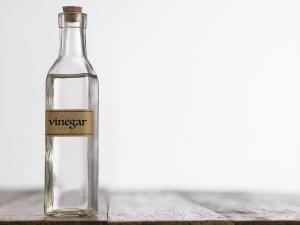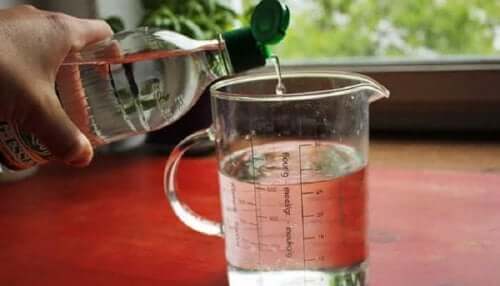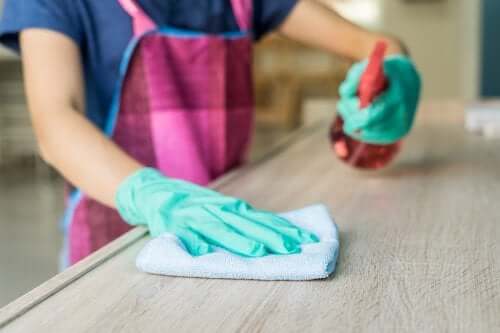How to Use White Vinegar to Clean Your House

Have you ever used white vinegar to clean your house? Although currently there are hundreds of products for any domestic chore, many people prefer this type of eco-friendly option. The best thing is that it has many uses, it’s safe, and cheap.
White vinegar is produced through the alcoholic fermentation of corn sugar or malt. The majority of people use it for cooking, since it works well on salads, dressings, or preserves. However, it also has various domestic uses.
How can white vinegar help clean your house?
Due to its antiseptic and antimicrobial properties, there are many ways to use white vinegar to clean your house. In fact, it was one of the most used cleaning ingredients in older times. Those uses are still valid today, and are noticed by people who want to take care of the environment.
This is due to the fact that, unlike detergents and other conventional products, it’s free of aggressive chemicals. Additionally, it doesn’t cause allergies and can be just as effective as many name brand products. Some of its uses for cleaning include:
- Elimination of stains on clothing and furniture
- Disinfection of surfaces (like bathroom or kitchen tiles)
- Deep cleaning of toilets and bathtubs
- Elimination of lime residue
- Shining metals
- Cleaning pots and pans
- Neutralizing bad smells
- Disinfecting refrigerators and ovens
- Cleaning grease residue
- Softening fabric
How to use white vinegar to clean your house
There are many ways to take advantage of white vinegar to clean your house. While it can be used by itself as a cleaning agent, it’s much more effective when combined with other natural ingredients like baking soda, salt, or lemon. Let’s take a look at a few options.
Multiuse cleaner

A multiuse cleaner with white vinegar can serve to remove grime from your kitchen, bedrooms, bathrooms, and more. It’s perfect for removing dust, grease stains, and other food residues. But the best part? It eliminates bacteria!
Ingredients
- 1 cup of white vinegar (250 ml)
- 1/2 cup of water (125 ml)
- 15 drops of tea tree oil or lemon oil
Preparation
- First, combine the white vinegar with the water.
- Then, add the drops of essential oil.
- Next, pour the preparation in a spray bottle.
- Spray it on the desired surfaces and clean!
Natural de-greaser
Grease residue is normally hard to remove without a special product. Fortunately, a combination of lemon and white vinegar can help to leave surfaces completely clean.
Ingredients
- 1 lemon
- 1/4 cup of white vinegar (62 ml)
Preparation
- First, cut the lemon in half and sprinkle the juices onto the greasy surface.
- Then, let it sit for 2 or 3 minutes, and then apply the white vinegar.
- Let it sit for another 10 minutes and then scrub and rinse.
You might like to read: The 5 Best Cleaning Solutions Using Baking Soda and Vinegar
Wood furniture cleaner

Using a combination of white vinegar and olive oil, you can clean and shine your wood furniture. It will also remove cup rings and prevent mold.
Ingredients
- 1/2 cup of white vinegar (125 ml)
- 1/4 cup of olive oil (62.5 ml)
Preparation
- First, pour the white vinegar into a jar or container.
- Then, combine it with the olive oil.
- Stir or shake until you get a homogenous mixture and then apply it to a surface.
- Finally, put a little on the wood surface and clean it with a cloth.
Laundry detergent
To push those chemical detergents that pollute the environment off to the side, you can try a combination of white vinegar and baking soda. It acts on your clothes, removing grime, and even stains. Additionally, the vinegar replaces conventional fabric softeners.
Ingredients
- 1 cup of baking soda (200 g)
- 1 cup of white vinegar (250 ml)
Preparation
- First, dissolve the baking soda in the white vinegar using a deep bowl or pot (since it will bubble up a lot).
- Then, pour the mixture into your washing machine, or use it to dampen the clothes before.
- Optionally, you can pour the baking soda and vinegar into the detergent compartments in the washing machine.
Have you already used white vinegar to clean your home? As you can see, it’s very useful for your regular domestic chores. Give it a chance and you’ll start to avoid other products that can be harmful.
All cited sources were thoroughly reviewed by our team to ensure their quality, reliability, currency, and validity. The bibliography of this article was considered reliable and of academic or scientific accuracy.
- Zota, A. R., Singla, V., Adamkiewicz, G., Mitro, S. D., & Dodson, R. E. (2017). Reducing chemical exposures at home: Opportunities for action. Journal of Epidemiology and Community Health. https://doi.org/10.1136/jech-2016-208676
- Michael C. Beuhler, Henretig, F. M., Gala, P., Meaney, P., Wolfe, H., Lewis, L., … Pillai, S. K. (2012). Health Hazards Associated with Laundry Detergent Pods — United States, May–June 2012. MMWR, Morbidity & Mortality Weekly Report.
- Mas, A., Troncoso, A. M., García-Parrilla, M. C., & Torija, M. J. (2015). Vinegar. In Encyclopedia of Food and Health. https://doi.org/10.1016/B978-0-12-384947-2.00726-1
- Pravasi, S. D. (2014). Acetic Acid. In Encyclopedia of Toxicology: Third Edition. https://doi.org/10.1016/B978-0-12-386454-3.00216-5
- Krehbiel, D. (2014). Acetic Acid Content of Vinegar.
This text is provided for informational purposes only and does not replace consultation with a professional. If in doubt, consult your specialist.








